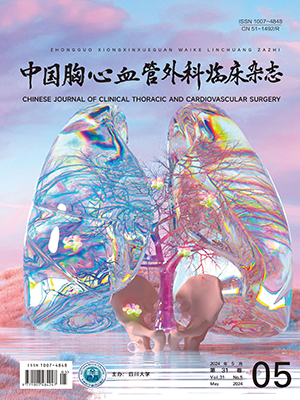Abstract: Objective To investigate the method of improving effect, by investigating and analyzing the possible risk factors affecting shortterm outcome after total correction of tetralogy of Fallot (TOF). Methods Data of 219 patients who received total correction of TOF were divided into two groups according to the length of postoperative stay in hospital and recovery of heart function in the near future. Group A(n=110): patients had good recovery of heart function classified as gradeⅠorⅡ(NYHA classification), and could smoothly be discharged from the hospital within two weeks without serious complications. The left ventricular ejection fraction (LVEF) had to exceed to 0.50 during 6 months followup visit. Group B(n=109): patients had worse recovery of heart function classified as grade Ⅱ or Ⅲ, and could not be discharged within two weeks with severe complications. LVEF was less than 0.50 during 6 months followup visit. The clinical data of two groups were compared, and risk factors affecting shortterm outcome after total correction of TOF operation were analyzed by logistic regression and model selection. Results There were good recovery of heart function classified as gradeⅠorⅡ(NYHA classification)in discharge, no death, and LVEF all exceeded to 0.50 in group A; there were 8 deaths in group B (7.34 %), and recovery of heart function was worse classified as grade Ⅱ or Ⅲ, with LVEF being less than 0.50(P lt;0.01). Amount of postoperative daily thoracic drainage, assisted respiration time, time of inotropic agent stabilizing circulation, and the average length of postoperative stay in group A were all less or short than those in group B(P lt;0.01). But the bypass and clamping time of group B were exceeded group A. The ratio of patching astride annulus in group B was greater than that in group A, and Nakata index was less than that in group A(P lt;0.01). The results of logistic regression and model selection indicate: age at repair (OR=0.69), oxygen saturation(OR=0.98), haematocrit before operation (OR=0.94), and patching astride annulus (OR=46.86), Nakata index (OR=16.90), amount of postoperative daily thoracic drainage (OR=0.84), presence of arrhythmia(OR=0.87), and wound infection(OR=63.57) have significant effect with shortterm outcome after total correction of TOF operation. Conclusions The probable methods to improving effect of shortterm outcome after total correction of TOF are an earlier age at repair, decreasing haematocrit, rising oxygen saturation before surgery, performing a palliative operation facilitating development of arteriae pulmonalis in earlier time, improving the surgical technique, and strengthening the perioperative care.
Citation: HE Weilai,ZHOU Ruyuan,LIN Min,GAO Qingyun,ZHENG Xiaoyan.. Analysis of Influential Factors on Shortterm Outcome after Total Correction of Tetralogy of Fallot. Chinese Journal of Clinical Thoracic and Cardiovascular Surgery, 2007, 14(4): 266-270. doi: Copy




